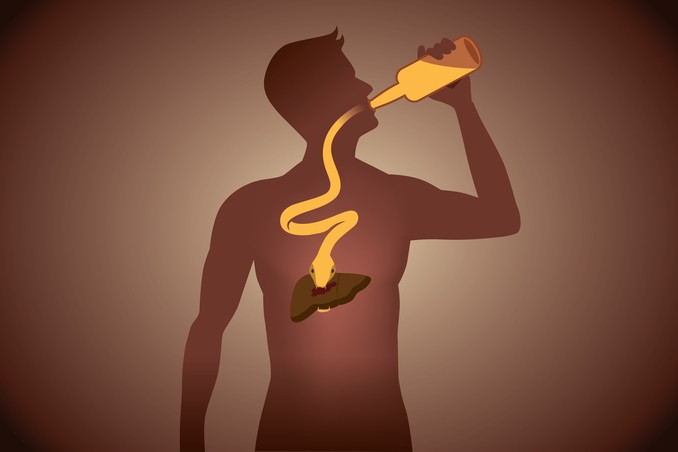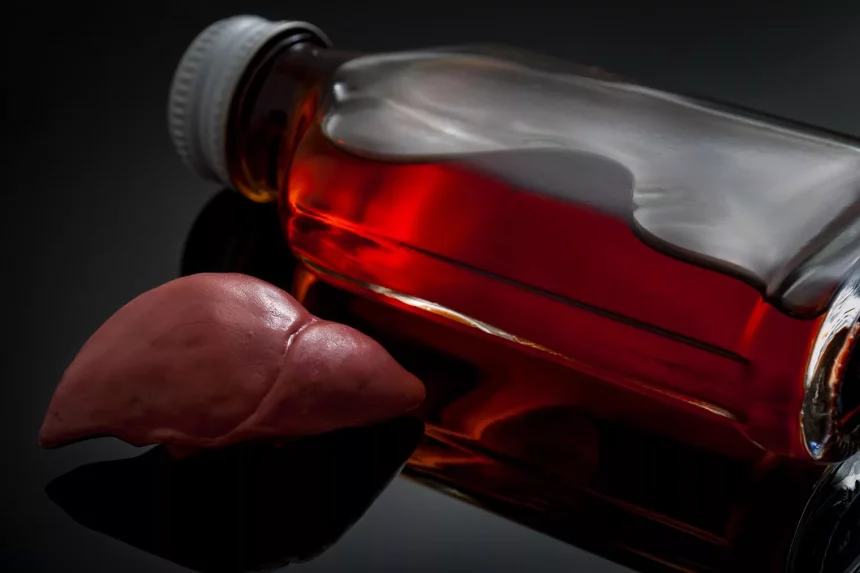Can The Liver Recover From Heavy Alcohol Abuse?
Table of Contents
Our livers play a vital role in the well-being of our bodies. As one of the largest organs, the liver’s primary function is to process and metabolize the nutrients from the food we consume. The liver also removes toxins from the body, builds proteins, and provides us with the protection necessary to ward off infections.
What many heavy drinkers would like to know more about is, ‘Repairing the Liver From Alcohol Abuse,’ which is fortunately the exact topic of our guide today.

While the liver is versatile and quite resilient, if it’s not taken care of, it can start a slow decline to poor health. The foods we eat and the beverages we drink have a direct effect on how our liver functions — this is especially true in the case of alcohol consumption.
Drinking alcohol in excess can cause severe damage to your body and your liver. Regardless of whether your binging is limited to the weekends or you drink on a daily basis, alcohol negatively impacts the liver and puts you at risk of developing a number of chronic health problems. Although the liver is programmed to break down and filter out toxins and harmful substances, it can only handle so much.
If a person drinks more than what their liver is capable of processing, they could be facing long-term liver damage. Luckily, with the right treatment and consistent abstinence from alcohol, the liver can start to heal, and some of the detrimental effects can be repaired.
How Does Alcohol Affect the Liver?
Did you know it takes approximately one hour to process one alcoholic beverage? Of course, age, gender, and weight can better determine a more precise time in each individual; however, this time frame only increases with each passing drink. Typically, the higher an individual’s blood alcohol content (BAC) is, the longer it will take for the liver to process the alcohol being consumed.
Since the liver can only process so much alcohol in a span of time, the rest that can’t be metabolized is left to be circulated through the bloodstream. The unprocessed alcohol then makes its way to the heart and brain, resulting in intoxication.
Additionally, when too much alcohol enters the body, it brings with it a toxic enzyme called acetaldehyde. If the liver can’t process the excess alcohol in one’s system, then it also can’t filter the acetaldehyde. The remaining unfiltered toxin can cause damage and scarring to the liver, stomach lining, and brain. Acetaldehyde is also responsible for hangovers, which can lead to headaches, nausea, and vomiting.
It’s important to note that alcohol has a diuretic effect on that body that can lead to dehydration. When someone ingests too much alcohol, they are depleting their body’s natural supply of water. The liver needs that water in order to filter and expel toxins from one’s system, and without that water, it has an even harder time processing the alcohol. More often than not, this will result in hangover-like symptoms the next morning.
Over time and with chronic abuse, alcohol can severely affect the liver by wreaking havoc on the liver cells. The elimination of liver cells can cause scarring on the liver (also known as cirrhosis), fatty liver disease, and other fatal conditions like alcoholic hepatitis and liver cancer.
The Stages of Alcohol-Related Liver Disease
Every time the liver needs to filter alcohol in excess, liver cells begin to die off slowly. Luckily, the liver is always in a constant state of regeneration, so the cells will continue to change and divide until the liver is properly restored.
However, when the liver and its cells have to fight off the toxins of alcohol continuously, it loses its ability to heal itself quickly. In mild alcohol use, the moment the liver is finished processing all the alcohol in the body, it begins to regenerate. But in cases of chronic use, this critical process can take anywhere from four weeks to several years.
Damage that the liver sustains by alcohol abuse is commonly referred to as alcohol-related liver disease (ARLD). Years of alcoholism can cause the liver to be swollen and in a constant state of inflammation, where it can begin to scar and develop into cirrhosis. If left untreated, this condition can be fatal. It’s estimated that over 70% of people with alcohol-related liver disease also suffer from an alcohol dependency problem — making the concept of ceasing alcohol to heal the liver a very difficult task for many.

The symptoms of alcohol-related liver disease can vary depending on which of the three stages a person is experiencing. The three stages of alcohol-related liver disease are as follows:
- Alcoholic fatty liver disease: The first stage of alcohol-related liver disease is alcoholic fatty liver disease. This is when fat deposits begin to accumulate around one’s liver after periods of excessive alcohol use. In this first stage, little to no symptoms are present, which makes it difficult to identify a problem. Luckily, alcoholic fatty liver disease can be reversed by the cessation of drinking alcohol.
- Acute alcoholic hepatitis: Acute alcoholic hepatitis is the second stage of alcohol-related liver disease and is the result of inflammation of the liver from alcohol abuse. Typically, acute alcoholic hepatitis is the first stage in which individuals begin to experience symptoms. Depending on the severity of the liver damage, there are forms of treatment that can reverse the disease. However, if left untreated, alcoholic hepatitis can result in liver failure.
- Cirrhosis: The third and most severe stage of alcohol-related liver disease is cirrhosis of the liver. Cirrhosis occurs when one’s liver cells are constantly damaged by chronic inflammation — a critical symptom of alcoholism. The diseased liver cells are then replaced with scar tissue. The presence of scar tissue makes it very difficult for the liver to carry out its proper function, as blood flow and fluids are inhibited. Unfortunately, scar tissue on the liver cannot heal or be repaired, and it often leads to liver failure. The only treatment for liver failure is receiving a liver transplant; however, those struggling with alcoholism are historically unqualified for liver transplantation due to their high risk of relapse.
Unfortunately, some individuals with ARLD don’t realize they have the disease until it’s far advanced because the symptoms don’t manifest right away. However, there are instances where signs and symptoms present themselves earlier — more often than not after binge drinking. The symptoms of alcohol-related liver disease include:
- Jaundice (yellowing of skin and eyes)
- Loss of appetite
- Abdominal pain and swelling
- Weakness and fatigue
- Swelling in the legs and ankles
- Disorientation
- Nausea and vomiting
- Itchy skin
- Fever
- Prone to bruising
- Bleeding gums
- Mood swings and agitation
If you are struggling with alcoholism and begin noticing any of the symptoms mentioned above, call your doctor or primary care physician right away. The sooner you’re able to treat alcohol-related liver disease, the better your chances are of healing. Most importantly, this may be the wake-up call you need to put down the bottle and start living a sober and healthy life.
How Much Alcohol Leads to Liver Damage?
It should be stated that every person responds differently to the food they consume, beverages they drink, and medications they take. This is especially true in the case of alcohol — what one person can safely drink may cause a severe reaction to someone else.
According to the National Institute on Alcohol Abuse and Alcoholism (NIAAA), there are established guidelines on what a standard drink looks like, as well as moderate to heavy alcohol consumption. Here are some of those defined drinking levels:
- In accordance with the U.S. Department of Health and Human Services and the U.S. Department of Agriculture, the NIAAA defines moderate drinking as up to one drink per day for women and up to two drinks per day for men.
- Binge drinking is classified as a pattern of intense drinking that elevates one’s blood alcohol concentration (BAC) to 0.08 percent or higher. For males, this is usually five drinks or more and four drinks or more for women in a period of about two hours.
- Heavy alcohol use is defined as more than four drinks on any given day for men and three for women.
- The standard drink equates to one 12-ounce beer, a 5-ounce glass of wine, or a 1.5-ounce shot of liquor.
One’s ability to sustain heavy alcohol consumption depends on a lot of factors like genetics, age, gender, weight, etc. While some may be able to drink heavily for years before showing signs of liver damage, others may experience it sooner with moderate drinking. Since the liver boasts a regenerative nature, it’s possible to avoid the life-threatening outcome of liver damage. Limiting your daily or weekly alcohol intake will greatly reduce your chances of developing alcohol-related liver damage.
Can You Reverse or Repair Liver Damage?

Liver recovery after alcohol abuse is possible. However, its potential for recovery greatly depends on the severity of damage already sustained and what stage of ARLD one is in — if they are, in fact, experiencing alcohol-related liver damage. The first and most important step in healing your liver after alcohol abuse is the cessation of all alcohol consumption.
The first stage of ARLD — fatty liver disease — is, luckily, an illness that can be reversed with the proper care. Stopping all alcohol consumption can help prevent further damage and promote the beginning stages of the healing process. Slowly, the liver will be able to return to its normal function. Like fatty liver disease, alcoholic hepatitis can also be healed when it’s caught early on. However, if left untreated, alcoholic hepatitis can result in liver failure and death.
Unfortunately, the last stage of liver failure — cirrhosis — is one of the most severe forms of liver damage and can’t be repaired or reversed. It’s still advised to quit all forms of drinking alcohol to help increase the life expectancy rate and prevent more damage.
In addition to the cessation of alcohol, whether abstinence has been attained through rehab or AA, or both, there are other treatment methods that can aid in the restoration of the liver. Many doctors recommend the following:
- Taking vitamin A supplements: Many individuals with ARLD have vitamin A deficiencies and need to take additional supplements to help them mend.
- Multivitamins: Multivitamins like B-complex vitamins are important to take when healing the liver. These vitamins help support healthy nutrition and fight against anemia.
- Liver transplant: In cases where the liver is too scarred from cirrhosis, the best chance for healing comes from receiving a transplant. As mentioned earlier, liver transplants are hard to come by for known alcoholics due to their high risk of relapse and repeated alcohol abuse. However, there are a few guidelines in place that enable those recovering from alcoholism to be considered a candidate for a transplant. Please speak to your doctor or primary care physician, as they will be able to provide you with more information.
Alcohol-related liver disease is treatable in the right circumstances. However, before you increase your intake of vitamins, it’s important to consult with your doctor or a medical professional first. This is especially important if you take any over-the-counter medications or prescriptions, as alcohol-related liver disease can affect how the body can process certain medications.
Importantly, it’s highly recommended for those struggling with alcoholism to consider enrolling in an alcohol rehabilitation program. With the right treatment and community of support, you can start your journey to sobriety and lead a happier and healthier life.
Outside of treatment, programs like Alcoholics Anonymous (AA) can provide you with the tools and support system to battle cravings and triggers and maintain sobriety.
Seeking Help on How to Heal Your Liver from Alcohol Abuse
Healing your liver from excessive drinking is a long process that requires hard work and dedication to lead a healthy lifestyle. Drinking plenty of hydrating fluids, eating a balanced diet, and exercising regularly while abstaining from alcohol are all excellent ways to help your liver heal and maintain proper liver function.
However, ceasing all consumption of alcohol is not something that everyone can easily do. If you have developed signs of liver damage, but can’t seem to quit drinking on your own, it may be time to seek professional help. If your liver damage is not too far progressed, it’s recommended that you enroll in a rehabilitation program that specializes in treatment for alcoholism.
A reputable facility will be able to help you properly detox and help you start the journey of recovery. Sobriety from alcohol just may be the factor that saves your life from the negative consequences of liver disease.
At Find Addiction Rehabs, we are here to help you through this challenging time in your life. We understand the strength and courage it takes to ask for help when you’re in such a vulnerable state. Our team of specialists is standing by the phone waiting to take your call so that we can help you take those next steps to sobriety. With a nationwide database of top-quality addiction rehabilitation and detox centers, we are able to carefully pair you with the facility that best meets all your personal needs.
Recovery from liver disease is possible, and so is recovery from alcohol abuse — but one cannot be done without the over. Your best chance for a healthy life is dependent on your willingness to treat your alcohol addiction. Let our team help you start this life-changing journey.
Call us today to learn more about our resources for alcohol addiction treatment.
Anna M. joined Find Addiction Rehabs with extensive experience in the field of addiction treatment. As a former Nurse Practitioner in Miami, she found her passion for addiction treatment when a family member was lost to his disease. With each article and resource, she hopes to save other families from experiencing the anguish of a loved one’s passing due to drinking or drugs.


